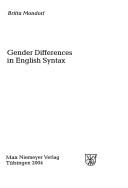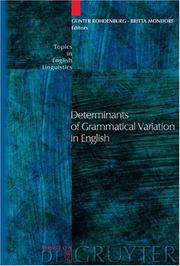| Listing 1 - 7 of 7 |
Sort by
|

ISBN: 348430491X 3110943379 Year: 2004 Publisher: Tübingen : Max Niemeyer Verlag,
Abstract | Keywords | Export | Availability | Bookmark
 Loading...
Loading...Choose an application
- Reference Manager
- EndNote
- RefWorks (Direct export to RefWorks)
What factors govern women's and men's use of syntactic alternatives? This is the central issue explored in the present volume, which provides the most comprehensive account so far of gender differences in syntax. By drawing on the theoretical frameworks of functional grammar (cf. Givón 1984, 1990), cognitive semantics and pragmatics, the book is able to show that the underlying characteristic of syntactic constructions that are sensitive to gender lies in their ability to encode epistemic meaning. Paying due attention to the closely intertwined relation between gender and a range of internal and external determinants, the present volume shows how apparently contradictory results in previous research can be reconciled. The internal and external factors investigated are: semantic type, position, intonation, pragmatic function - style, power, surreptitiousness, group composition. The Labovian 'Vanguard of Change' and 'Linguistic Conformity of Women' Principles (Labov 2001) are supplemented by an 'Epistemic Modality Principle' (stating that women are more prolific users of epistemic downtoners than men) and a 'Turn-Allocation Principle' (assessing that women use more completion signals than men in the negotiation of floor-apportionment). These principles are crucial in paving the ground for an explanation of gender differences in language. This volume is essential reading for those interested in language and gender and in how functionalism can be brought to bear in illuminating language structure and use.
English language --- Sex differences --- Gender. --- Syntax. --- Germanic languages --- ANGLAIS (LANGUE) --- SYNTAXE --- USAGE
Book
ISBN: 1282395505 9786612395505 9027289271 9789027289278 9789027234841 9027234841 Year: 2009 Publisher: Amsterdam Benjamins
Abstract | Keywords | Export | Availability | Bookmark
 Loading...
Loading...Choose an application
- Reference Manager
- EndNote
- RefWorks (Direct export to RefWorks)
This book provides the most comprehensive account so far of novel and hitherto unexplained factors operative in the choice between synthetic (prouder) and analytic (more proud ) comparatives. It argues that the underlying motivation in using the analytic variant is to mitigate processing demands - a compensatory strategy referred to as more -support. The analytic variant is claimed to be better suited to environments of increased processing complexity - presumably owing to its ability to facilitate early phrase structure recognition, the more transparent one-to-one relation between form and function and possibly because the degree marker more can serve as a structural signal foreshadowing cognitive complexity. A bird's eye view of 24 determinants reveals that the processing effort which triggers the analytic comparative emanates from structures that are phonologically, morphologically, syntactically, lexically, semantically or pragmatically complex. By bridging the gap between corpus-based variation research and psycholinguistic and typological approaches, the book breaks new ground in uncovering the functional motivation behind the continued variability of synthetic-analytic contrasts.
English language --- Comparison (Grammar) --- Grammar, Comparative and general --- Comparison. --- Adjective. --- Comparison --- Nominals --- Adjective --- Grammar --- Comparison (Grammar). --- Germanic languages
Book
Year: 2005 Publisher: Paderborn: Universität Paderborn. Rektorat,
Abstract | Keywords | Export | Availability | Bookmark
 Loading...
Loading...Choose an application
- Reference Manager
- EndNote
- RefWorks (Direct export to RefWorks)

ISBN: 9783110943375 3110943379 348430491X 9783484304918 Year: 2011 Publisher: Tübingen
Abstract | Keywords | Export | Availability | Bookmark
 Loading...
Loading...Choose an application
- Reference Manager
- EndNote
- RefWorks (Direct export to RefWorks)

ISBN: 9783110900019 3110900017 3110176475 9783110176476 Year: 2003 Publisher: Berlin Mouton de Gruyter
Abstract | Keywords | Export | Availability | Bookmark
 Loading...
Loading...Choose an application
- Reference Manager
- EndNote
- RefWorks (Direct export to RefWorks)
What factors influence the choice between alternative grammatical structures such as the following: a lit / a lighted cigarette, more full / fuller of convincing arguments, the main thesis of the book / the book's main thesis, take hostage a group of 15 holiday makers / take a group of 15 holidaymakers hostage, conceding that the argument is convincing / conceding the argument to be convincing? This is the central issue explored in this volume, which contains a unique selection of innovative in-depth empirical studies written in a broadly functional framework. The factors investigated include the following: phonological influences (such as the principle of rhythmic alternation and optimal syllable structure), frequency, pervasive semantic and pragmatic aspects (including iconicity, markedness, grammaticalization and typological tendencies), information structure, processing complexity and horror aequi (the avoidance of identity effects).
English language --- Grammar --- Grammar. --- Variation. --- Variation

ISBN: 3110176475 3110900017 9783110176476 Year: 2011 Volume: 43 Publisher: De Gruyter
Abstract | Keywords | Export | Availability | Bookmark
 Loading...
Loading...Choose an application
- Reference Manager
- EndNote
- RefWorks (Direct export to RefWorks)
What factors influence the choice between alternative grammatical structures such as the following: a lit / a lighted cigarette, more full / fuller of convincing arguments, the main thesis of the book / the book's main thesis, take hostage a group of 15 holiday makers / take a group of 15 holidaymakers hostage, conceding that the argument is convincing / conceding the argument to be convincing? This is the central issue explored in this volume, which contains a unique selection of innovative in-depth empirical studies written in a broadly functional framework. The factors investigated include the following: phonological influences (such as the principle of rhythmic alternation and optimal syllable structure), frequency, pervasive semantic and pragmatic aspects (including iconicity, markedness, grammaticalization and typological tendencies), information structure, processing complexity and horror aequi (the avoidance of identity effects).
English language --- Grammar --- Variation --- Grammar. --- Variation. --- 802.0-56 --- 802.0-56 Engels: syntaxis; semantiek --- Engels: syntaxis; semantiek --- Dialects --- Analysis and parsing --- Diagraming --- Composition and exercises --- Germanic languages --- English language - Grammar --- English language - Variation
Book

ISBN: 9783110592498 3110590123 3110592495 Year: 2018 Publisher: Berlin Boston
Abstract | Keywords | Export | Availability | Bookmark
 Loading...
Loading...Choose an application
- Reference Manager
- EndNote
- RefWorks (Direct export to RefWorks)
Most scholars define reduplication as a formally restricted grammatical process, neatly distinguishing it from 'mere' repetition as a discoursal option. However, there is a fuzzy grey area between the two processes that has rarely been explored so far. In this timely collection, the phenomenon of exact repetition, understood broadly as the systematic iteration of one and the same linguistic item within relatively close syntactic proximity, is investigated from a number of angles. The volume contains studies from phonology, morphology, syntax, semantics, and pragmatics, and deals with a broad range of languages, including alleged 'reduplication avoiders'. In bringing together different theoretical perspectives, phenomenological domains, and methodologies, and in linking the fields of syntax and discourse to those of morphology and morphophonology, the volume provides new insights into the structure and meaning of exact repetition phenomena, and, more generally, into their status within a theory of language. The collection will appeal to formally and functionally oriented scholars from all subfields of linguistics, including typology.
| Listing 1 - 7 of 7 |
Sort by
|

 Search
Search Feedback
Feedback About UniCat
About UniCat  Help
Help News
News